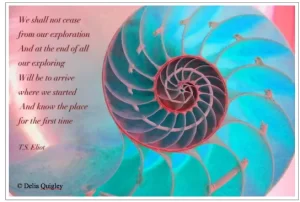I am appreciating the turn of focus back upon my core, therapeutic training in the humanistic tradition that my second book is inviting. I have a general thirst for understanding psyche, and as a result my reading is spread wide across disciplines; this breadth not only helps my practice, it helps my teaching – especially on our MSc psychotherapy programme where I am in regular contact with trainees in the psychodynamic schools. I take a lot from Jungian, Object Relations, Self-psychology as well as Freudian psychoanalysis. However, this focus back is reminding me why I decided upon the existential-phenomenological training as my choice.
 If anything however, it is as if the foray into the vast schools of counselling and psychotherapy was needed to come back and go deeper. I am feeling a TS Eliot moment…
If anything however, it is as if the foray into the vast schools of counselling and psychotherapy was needed to come back and go deeper. I am feeling a TS Eliot moment…
To be returning, re-engaging, and only now truly knowing what the great thinkers and pioneers were setting out through the humanistic view of the world and the beings-in-the-world.
As I sit and try to encapsulate that re-knowing, the word that comes to mind is “experiencing”. The work of Alvin Mahrer, who authors a book of that title, was fundamental in re-visiting and re-considering just how the humanistic tradition views human nature, the causes of distress, and it’s subsequent healing; it also allowed me to interrogate how it is, exactly, that “awareness itself is curative” (to use words from Fritz Perls, one of the founders of the Gestalt approach I primarily draw upon in the room with clients).
Awareness, experiencing.
My recent re-visiting and re-searching of the pioneers in the humanistic tradition – both those coming from the psychology and those from the philosophy strands – had me land in the work of Rollo May; and I shared some thoughts on art, creativity, and phenomenology last week. Another aspect of May’s work that has touched me is his description of the “‘I am’ experience”. Through a description that originally came from a dreamer’s process, May explains it is all too common for us to associate ourselves with external factors: I am a therapist, I am a teacher, I am a wife, I am a cyclist, etc. Our own sense of being is repressed in these labels. What is left if we remove the labels, or what is common in each of these statements? I am! “If I am, I have a right to be” (May & Yalom, 1995*). This realisation is not the solution to my problems, but it is a necessary precondition to finding the courage to pursue the rest of my life. Another way of framing this is to state we are NOT the experience but rather that which is experiencing.
Experiencing, self-ing
We move from the solidity of an experience to the experiencing of it.
With May in the forefront of my thinking, this notion of experiencing or the self arising in each moment (self-ing) has been a theme in my teaching work lately. At the heart of the humanistic tradition, we see “health” as the fluidity of a self that meets needs spontaneously, appropriately; without scripts, free from fixed notions of rights and wrongs, without pressure of “shoulds” and “musts”. And so, in experiential workshops**, I have been inviting a focus on this process of self-ing; to turn attention away from the stories “out there” (from the client), and turning “in here” to experiencing. Everything expressed in its verb form: thoughts as ruminating, regretting, predicting; physical sensations as pinging, pulsing, racing, contracting; and feelings as fearing, hoping, even sad-ing!
To know experiencing
To know and yet not always act
This opens up what all humanistic therapists come to learn through the work of Carl Rogers…
“In place of the term “realness” I have sometimes used the word “congruence.” By this I mean that when my experiencing of this moment is present in my awareness and when what is present in my awareness is present in my communication, then each of these three levels matches or is congruent” (Rogers, A Way of Being).
Experiencing, awareness, communication

Congruence is often misunderstood, especially in how it plays out in clinical practice with clients. The explication from Germain Lietaer, a person-centred therapist and writer, has been very helpful to me over the years. He points out that between those three “levels” is the inner aspect of congruence (awareness of experience) and the outer (in that knowing, what to do with it, if anything). The common mistake trainees make is that “to be authentic” or to be “real” we should declare it? And yet to do so, “surely that contravenes the need to not disclose to our clients?”
Thinking of inner and outer congruence is helpful because it allows the truth of our reality and the choice of how useful that sharing is for the client. “Always in service of the client” we hear Irving Yalom cry in his advice about disclosure.
As I have been sharing with trainees in this past week, to be congruent is to bring our full humanity to the relationship. And we KNOW that is the healing aspect of this “dark art”, research points to this no matter the modality (even CBT). And, we can be congruent without the need to make disclosures – I can be fully Helen without sharing what I am doing for my summer holidays, without revealing the details of my personal life. Therapists and clients can often experience throughout the therapeutic journey together, but especially at the ending, a sense of “knowing so much yet nothing at all” of each other. For sure, it IS a less than equal “knowing” on the part of the client; and yet they DO get to know us on the levels and in the ways that are important for them (Back to Yalom).
There are moments, on that ledge between knowing and communicating, where choices are being made; computations (as to what is helpful, in service, maintaining one’s privacy). Trainee’s often ask me, “how do you know what is helpful or not, how do we decide?” And so I suggest in those moments of computation “show your working out”.
Client: So, you are on holiday next week…going anywhere nice?
Me: When I hear that question, I feel torn. On one hand it feels such a natural question and an easy answer to give; and yet I am also wondering where the question comes from. If I were to simply answer, I might miss what you really want me to know (or ask) in that moment. What is happening for you when I share my dilemma?
Here, I am honest and yet not disclosing
And by extension, such moments also come up in the training environment: and not necessarily from direct questioning. I have often sat, witnessing trainee anxieties about their practice or workshop participation. This manifested recently in a concern about working therapeutically through embodiment. Holding that tension across being both trauma-sensitive yet committed to wholeness requiring integration of ALL experiencing, I arrived at a choice point – it felt “in service” to these anxious beings to disclose my own path of embodiment via the blind alley of athleticism and gateway of chronic fatigue. My own felt response to their anxiety to proceed, and the choice to use this through the communication of something personal. Key? Showing my working out: that my disclosure was an invitation for their own, courageous integration of distress.
I think it is fair to say that I am more likely to disclose the details of my own story in the training environment; but that is not to say there aren’t times I do this in the therapy room. The map of the enneagram has been a useful frame for walking that ledge between inner and outer congruence, and between collusion*** and disclosure. With clients that know the system, divulging myself as identifying with “Six process” allows dynamics rather than than details to come into the room; it also helps a client in shaping their own journey from passion to virtue whilst developing compassion for all Nine ways we suffer and perpetuate the patterns that lead to that suffering.
In both the training environment and the therapy situation, skilful use of self and our self-ing can help dispel that inevitable power that resides; whether teacher and student, therapist and client. To share “I suffer too” can help convey not only that our propensity to suffer is not personal or a failing, but also to throw out the shadow of shame. Futhermore, if my story from passion to virtue can bring hope or relief, is that not the most compassionate act and ultimate service?
_________________________
*May, R., and Yalom, I. Existential psychotherapy. In: Corsini, R.J., and Wedding, D., eds. Current Psychotherapies. 1995; 5th ed. Itasca, IL: F.E. Peacock
** like it says on the tin, workshops that support experiencing!
*** to be mindful when we disclose out of awareness to fabricate a sense of closeness.

